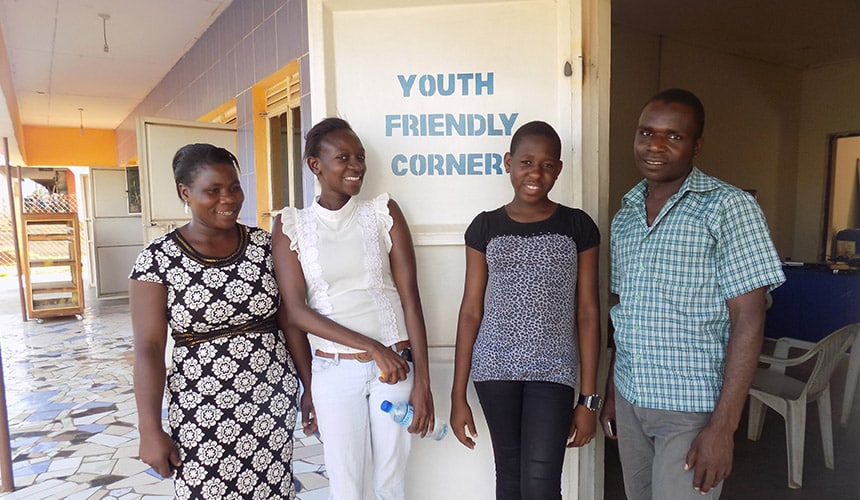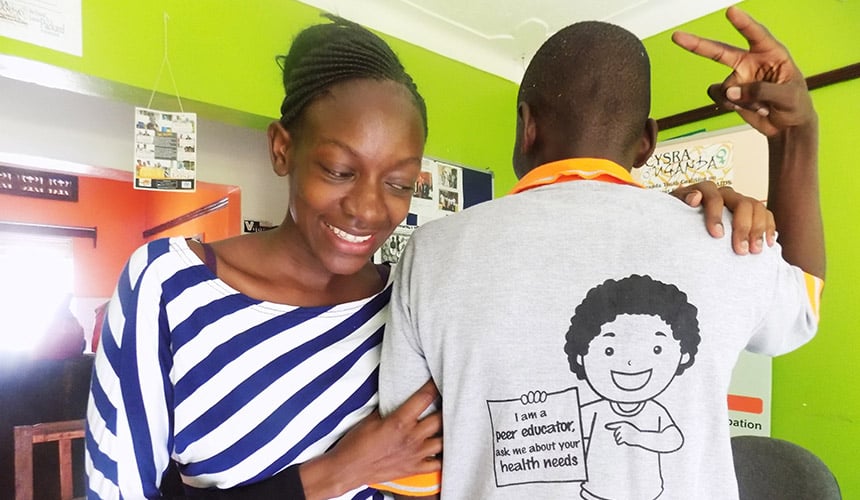The Problem
Uganda’s adolescent fertility rate is among the highest in Eastern Africa at 122 births per 1,000 women. Usage of modern contraceptive methods among youth is low—7 percent for those ages 15 to 19 years, and 22 percent for those ages 20 to 24 years. Inadequate access to information about family planning services and methods is a key barrier to adolescent contraceptive use. In addition, facilities often do not have preferred contraceptive methods in stock and are inexperienced in meeting the needs of younger clients.
The Solution
This project (“Vijana,” or “youth” in Swahili) aims to increase contraceptive use among youth ages 18 to 25 by increasing their knowledge about family planning and improving the quality of contraceptive services at health facilities. Leveraging new technologies as well as traditional dissemination tools, Vijana shares accurate, comprehensive information on family planning with youth. At the facility level, the project addresses contraceptive shortages and trains providers on how to adapt family planning services for youth. The project also builds a supportive environment for providing high quality, youth-friendly family planning services by bringing a range of stakeholders together to discuss barriers and solutions related to adolescent sexual and reproductive health (SRH) practices.

The Strategy
Encourage discussion of family planning information through:
- Youth family planning ambassadors. These ambassadors were identified through school clubs, as well as out-of-school groups for sex workers, youth with HIV, youth with disabilities, and youth in fishing communities. Twenty-five ambassadors in each of three focus districts were trained to share information on family planning with their peers and encourage them to use contraceptives and facility-level SRH services.
- Community meetings and events to promote dialogue. Project staff worked with debate clubs in 24 schools to facilitate quarterly debates on family planning issues. They also held quarterly football competitions, followed by “visiting periods” where youth could ask questions, share concerns, and access contraceptives. Monthly community dialogues, a critical component of the project, reached a broader audience. Youth, parents, religious leaders, district officials, and members of parliament were invited to these events and encouraged to engage in open discussions about family planning issues.
- Technology- and media-based dissemination. Project staff organized radio talk shows to share information on family planning with a broad audience, inviting youth ambassadors, district officials, and facility staff to participate. The project also provided information through social media—specifically Facebook pages and Whatsapp mobile messaging groups that youth ambassadors encouraged their peers to join. Toll-free numbers were provided to enable youth to obtain information about family planning.
Increase access to contraceptives by:
- Improving contraceptive supply at facilities. To avoid contraceptives being out of stock, grantees encouraged public facility staff and government officials to prepare and approve paperwork in a timely manner. They also worked with accredited private facilities, helping them order contraceptive stock from the government and ensuring that they attended government review meetings and built relationships with authorities.
- Distributing condoms through nontraditional outlets. The project attempted to distribute free government-supplied condoms through retail shops, kiosks, and supermarkets.
- Build capacity of family planning providers to deliver youth-friendly services. The project trained 10 facility-level providers in
each of the three focus districts on how to communicate with and meet the family planning needs of young clients. The facilities were asked to hold a youth clinic once a week.
Little information is provided to youth on where to get services, and there are many myths surrounding family planning issues in Uganda. I think this project has been able to clear things up quite a bit for the youth we have managed to reach.
—Project staff member
Achievements
Monitoring data suggest that the project has reached 60,000 youth. Event attendance lists, toll-free line data, and activity on Whatsapp and Facebook indicate the project reached a large number of youth from
diverse groups.
The project connected high-level government officials with grassroots issues, facilitating tangible change in family planning services. By bringing together diverse stakeholders, the project increased awareness of family planning challenges among influential government representatives, and empowered beneficiaries to advocate for change. District officials earmarked funding for a youth center after they heard youth at a community dialogue event discuss their reproductive health needs.
Challenges
Poor internet connectivity limited access to social media. In rural areas with weak network coverage, social media was difficult to access. Whatsapp mobile messaging was quicker to load but not available to youth without smart phones, of which there are many in rural Uganda. The project tried to expand its information dissemination in remote areas through call-in segments on radio talk shows.
Discussion of family planning issues in schools is challenging. Project staff encountered resistance to sharing SRH information in schools, many of which were founded by religious institutions and tend to be conservative on family planning issues.
It was difficult to persuade nontraditional outlets to stock no-cost contraceptives provided by the government. Supermarkets and retail shops were concerned that making free condoms available to customers would reduce sales of the branded condoms they offered.

Key Learnings
- Involving youth in efforts to improve adolescent uptake of family planning services can be highly beneficial. Youth peer ambassadors were highly engaged in the project, sometimes conducting activities such as school debates more frequently than planned. Their ownership and advocacy were critical to building momentum around family planning issues and increasing service use among youth.
- Collaboration between organizations with different areas of expertise can help drive success. The grantees have complementary areas of expertise that align closely with the needs of the project and position it to reach its goals. CYSRA has expertise in promoting dialogue among youth on SRH issues. MAI is experienced in working with providers on service delivery. NWMP, with its close access to government, engages policymakers in discussions surrounding family planning.
- Innovative, multi-component interventions funded by small, short-term grants are at risk for scope modifications. Grantees had to narrow their focus to complete planned activities. Youth outreach was more limited than planned, and some activities like community dialogues and sporting events were combined. Because of the high costs associated with establishing a call center for the toll-free line, grantees decided instead to provide youth with numbers for toll-free lines run by other family planning organizations in the country.
Next Steps
The three grantee organizations are trying to obtain additional funding to continue implementing project activities. An endline assessment will measure the project’s influence to date.
Implementing Partners
Mama Alive Initiatives (MAI)
The Uganda Youth Coalition on Adolescent Sexual and Reproductive Health Rights and HIV (CYSRA-Uganda)
The Uganda Chapter of the Network of Women Parliamentarians and Ministers (NWMP-Uganda)
Location
Uganda—Busia, Mityana, and Ssese Islands (or Kalangala) districts
Categories
Youth
Year Awarded
2013
Project Timeline
June 2014 – June 2015
About the Grantee and Partners
CYSRA-Uganda is a coalition of youth-led organizations and networks advocating for high quality sexual and reproductive health services for high-risk adolescent populations, including adolescents with HIV, sex workers, and adolescent mothers, in underserved communities in Uganda.
MAI is a nonprofit public health and community development organization that aims to improve reproductive, maternal, newborn, and child health in underserved communities by building the capacity of community-based organizations, engaging the private sector in health systems strengthening, and conducting health marketing to help individuals make informed decisions.
NWMP is an Africa-wide network of women parliamentarians and ministers that promotes equal representation of women and men in policy- and decision-making processes. The Uganda chapter advocates for maternal-health-related legislation and resource allocation.